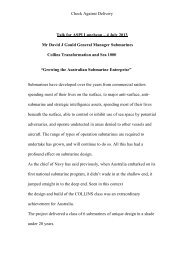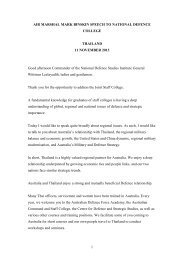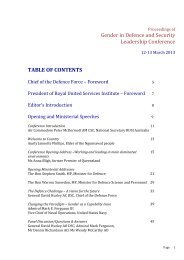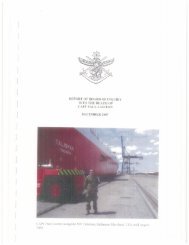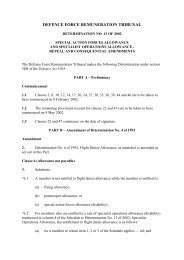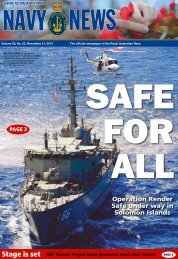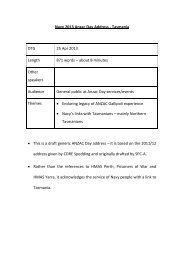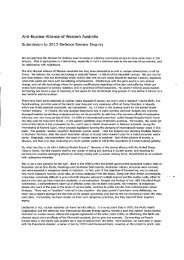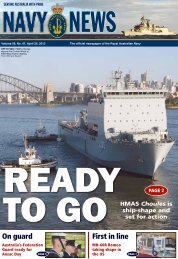Create successful ePaper yourself
Turn your PDF publications into a flip-book with our unique Google optimized e-Paper software.
<strong>Joint</strong> Directive <strong>006</strong>/<strong>2010</strong> (13 May <strong>2010</strong>)<br />
Objective and Scope of the ADF Airworthiness Management System<br />
ASS: Mission Planning Systems<br />
OAA: Relevant OAA as assigned for the aircraft type supported
SCOPE<br />
• Background<br />
• Mission Planning – General<br />
• Mission Planning Systems (MPS)<br />
• MPS Inputs<br />
• MPS Support<br />
• Technical Considerations
BACKGROUND - MISSION PLANNING SYSTEM<br />
• NPRM DGTA 03-09<br />
AAP7001.054 Section 2 Chapter 24<br />
Flight and Mission Planning<br />
Systems<br />
• Why?<br />
Relatively new capability<br />
within the ADF<br />
Not understood well in<br />
technical realm<br />
Standardisation<br />
Who is using it?<br />
What are the Risks?<br />
How far do we go to regulate<br />
and control?<br />
How does this affect operation<br />
of our particular aircraft?<br />
MPS Stakeholder ~ 2005
BACKGROUND - MISSION PLANNING DEFINED<br />
Mission Planning is a process conducted by<br />
competent and approved individuals who are<br />
acting as members of an approved organisation,<br />
in accordance with approved standards and<br />
limitations, for specific mission conditions.<br />
Mission considerations include mission<br />
objectives, platform capabilities and limitations,<br />
crew competencies, environment, threat<br />
information and risk assessment.<br />
Mission Planning outputs undergo validation<br />
during flight authorisation and mission conduct.
BACKGROUND – TRADITIONAL MISSION PLANNING<br />
TASKING (ATO / ACO)<br />
COORDINATE / DECONFLICT<br />
Flight Manual (-1-1)<br />
Weapons Data<br />
Aeronautical Data<br />
FLIP<br />
MAPPING / GIS<br />
WEATHER/ ENVIRONMENTAL<br />
THREAT / INTEL<br />
Chart Amendments<br />
MISSION<br />
PLANNING<br />
Marked Maps<br />
Knee Cards<br />
ICAO Flight Plan<br />
Aircraft Configuration<br />
Flight Authorisation
AIRWORTHINESS AND MISSION PLANNING<br />
• Mission Planning Systems provide a tool-set to:<br />
• Supplement mission planning;<br />
• Aid Operational Decision Making;<br />
• Prepare data for tranfer to aircraft systems; and<br />
• Support Post Mission debriefing.<br />
• MPS components should focus on:<br />
• Utility, Workload, Visualisation & Alignment<br />
• Airworthiness considerations need to include the normal stuff:<br />
• System Safety Assessments relative to specific platform<br />
• On-going Airworthiness & System Maturity<br />
• Training and Standardisation<br />
• Normal Flight Authorisation processes are not changed
BACKGROUND – MISSION PLANNING SYSTEMS<br />
TASKING (ATO / ACO)<br />
COORDINATE / DECONFLICT<br />
Flight Performance Model<br />
Weapons Data (TACMAN)<br />
DAFIF / AusDAFIF / ECHUM<br />
FLIP<br />
MAPPING / GIS<br />
WEATHER/ ENVIRONMENTAL<br />
THREAT / INTEL<br />
Manual Chum<br />
VVOD/DVOF<br />
Standard Forms<br />
Standard Configuration<br />
Computers are good with numbers<br />
People are good with pictures<br />
Use the automated system to process the<br />
numbers and the person to make the<br />
decisions<br />
MISSION<br />
PLANNING<br />
Maps and Knee Cards<br />
Data Cards<br />
ICAO Flight Plan<br />
Aircraft Configuration<br />
Flight Authorisation
SOFTWARE<br />
THE MISSION PLANNING SYSTEM - SYSTEMS VIEW<br />
Implement local procedures,<br />
training and first line support<br />
Mission Staff<br />
Planning<br />
Rehearsal<br />
Monitoring<br />
Debrief<br />
Common Components (CC) MPS (Core) Unique Planning Components (UPC)<br />
Combat Airdrop Planning Software<br />
(CAPS)<br />
Performance Planning<br />
Take-Off / Landing Data<br />
DMO acquires and sustains<br />
capability inclusive of product<br />
maintenance, enhancements and<br />
new developments.<br />
Mission Planning Tools<br />
Visualisation<br />
Calculation<br />
Mission Outputs<br />
Data Inputs<br />
Maps & Imagery<br />
Aeronautical Data<br />
Weather<br />
Intelligence<br />
Specific to individual<br />
platforms and<br />
developed through<br />
collaboration.<br />
Development best<br />
managed centrally<br />
Flight Performance Model (FPM)<br />
Aircraft/Weapons/Electronics (AWE)<br />
Independent Software Modules (ISM)<br />
Data is sourced from<br />
approved suppliers such as<br />
DIGO and RAAF AIS. This<br />
data is distributed on fixed<br />
networks.
MISSION PLANNING SYSTEMS<br />
Systems in Use<br />
• US DoD Systems<br />
• Portable Flight Planning System (PFPS) – modular design – in use in 26 Countries<br />
• <strong>Joint</strong> Mission Planning System (JMPS) – modular design – much in common with PFPS<br />
• X-Plan – Execution Planner in development (read PFPS 5.0)<br />
• Other Systems:<br />
• ARH Tiger – Ground Mission Management Environment – Thales (Australia)<br />
• MRH90 – Ground Mission Management System – Thales (Australia)<br />
• MRTT – Mission Planning Tool – Thales (Europe)<br />
• AEW&C – Jeppesen MilPlanner (Front), Mission Support System (Back)<br />
Standardisation promotes interoperability cross platform and coalition<br />
Interfaces between disparate systems provide short term interoperability and long term support problems<br />
ACAUST Direction<br />
The designated Mission Planning System of the RAAF is to be PFPS<br />
AVM Binskin, 26 Nov 07, HQAC 2007/1117142
CORE APPLICATIONS - FALCONVIEW<br />
PFPS, JMPS and X-Plan all<br />
use Falconview as the<br />
2D Geospatial Viewer.<br />
Falconview supports a<br />
large range of map and<br />
imagery types (Military<br />
and Civil)<br />
Falconview is capable of<br />
overlaying a large range<br />
of data types and<br />
supports collaborative<br />
planning.
CORE APPLICATIONS – COMBAT FLIGHT PLANNING SOFTWARE<br />
CFPS (Tabular Viewer in JMPS)<br />
provides a Tabular Route<br />
planning application, which<br />
interfaces to Falconview.<br />
Routes created in CFPS are<br />
graphically viewed in<br />
Falconview (and visa-versa)<br />
CFPS uses performance models<br />
for a wide variety of platforms<br />
(Air, Land and Sea) to compute<br />
highly accurate route<br />
parametrics including timings,<br />
distances, fuel usage, torque,<br />
hover performance etc.<br />
Multiple routes can be planned<br />
simultaneously and calculated<br />
at the touch of a button.
CORE APPLICATIONS – OTHER<br />
The US DoD Software includes a large array of Application/Capabilities.<br />
These include:<br />
-Skyview (3D Flythrough)<br />
-Taskview (Parsing of Air Task Orders & Airspace Control Orders)<br />
-Route Analysis Tool (Route Deconfliction)<br />
-Various Administrative Support Tools
COMMON COMPONENTS<br />
WEAPONS DELIVERY SOFTWARE<br />
• Provides access to conventional and precision weapon<br />
planning modules relative to specific platforms.<br />
COMBAT AIRDROP PLANNING SOFTWARE<br />
(CAPS)<br />
• Determines minimum drop zone dimensions<br />
based on ballistic data and computational<br />
procedures<br />
COMMAND FLIGHT PLANNER FOR CFPS – NAIPS<br />
INTERFACE<br />
• Provides an interface with Air-Services Australia for the<br />
collection of winding data and flight plan submission<br />
PERFORMANCE PLANNING<br />
• Computation of Take-Off and Landing Data,<br />
Manueovre and Hover data. Integrates tightly with<br />
PFPS, removing the need to double up on data entry<br />
STORES LOADING AND BALANCE (SLAB)<br />
• Provides graphical interface for stores loading, along<br />
route; computing the movement of CoG. Produces load<br />
plans<br />
OTHER COMMON COMPONENTS<br />
• Visual Vertical Optimiser<br />
• Approach Planning Tool<br />
• Electronic Warfare
UNIQUE PLANNING COMPONENTS – FLIGHT PERFORMANCE MODELS<br />
• The basis for development of an FPM is an<br />
Aircraft Flight Manual. This contains the<br />
approved modes of flight and aircraft performance<br />
limitations.<br />
• Where aircraft are operated in accordance with<br />
US DoD procedures and limits, US DoD FPMs<br />
may be used. This is the case for the C-17.<br />
• The following FPMs have been<br />
developed specifically for the ADF:<br />
• C130J-30<br />
• Hawk 127<br />
• King Air B350<br />
• Pilatus PC9A<br />
• P3C Orion<br />
• Bell 206B-1 Kiowa<br />
• Blackhawk S-70 & S-70 ESSS<br />
• Boeing Chinook<br />
• Seahawk (S-70B-2)<br />
• The FPM facilitates the concise<br />
computation of mission data (not<br />
rules of thumb)<br />
• The full benefits of the MPS are not<br />
realised without a FPM. This also<br />
effects inter-operability<br />
inter operability<br />
• The FPM should incorporate all<br />
parameters a mission planner may<br />
use to prepare a mission.<br />
• Automated outputs of this system<br />
should be within 5% of manually<br />
calculated data.<br />
• Aircraft configuration and<br />
performance changes may warrant a<br />
modification of the FPM<br />
Appropriate Authorisations are required to use FPMs Authoritatively Authoritatively<br />
.<br />
Consideration must be applied to training, standardisation, maturity maturity<br />
and support.
UNIQUE PLANNING COMPONENTS – FLIGHT PERFORMANCE MODELS<br />
Super-Hornet<br />
Hercules
UNIQUE PLANNING COMPONENTS – FLIGHT PERFORMANCE MODELS<br />
• Support Data –<br />
Australian Developed FPMs<br />
• Software Version Description (SVD)<br />
• Software Requirements Specification (SRS)<br />
• Data Substantiation Report (DSR)<br />
• Software Test Plan (STP)<br />
• Software Test Description (STD)<br />
• Software Test Report (STR)<br />
Flight &<br />
Performance<br />
Manuals<br />
Contractor<br />
Development<br />
FPM &<br />
Support Data<br />
Wing Testing<br />
• Support Data –<br />
US DoD – MOTS<br />
• Software Version Description (SVD)<br />
• Possibly<br />
• US DoD AwR<br />
• Associated Test Reports<br />
Issues<br />
• Visibility of updates<br />
• Visibility of Deficiency Reporting
UNIQUE PLANNING COMPONENTS – AIRCRAFT INTERFACES<br />
Aircraft / Weapons / Electronics<br />
• The basis for development of an aircraft<br />
interface is the overarching capability of the<br />
aircraft systems to receive and transmit<br />
mission data.<br />
• An aircraft AWE can be a singular<br />
application or multi-use application. The<br />
latter can reduce support cost significantly<br />
• An effective aircraft interface shall be<br />
capable of:<br />
• Utilising MPS mission data without re-keying<br />
• Augmenting the MPS data with aircraft specific<br />
data such as radio presets and sensor data<br />
• Produce the necessary data cards or binary<br />
files seamlessly<br />
A-S SAFETY OK<br />
VALID KEYS<br />
MSG
DATA INPUTS – MAPPING AND IMAGERY<br />
• Digital Mapping, Imagery and Vector<br />
Product<br />
• The MPS supports a wide range of mapping and<br />
imagery products at various scales<br />
• Mapping and imagery data used by the MPS should<br />
be seamless with no boundary information<br />
• The resolution should be sufficient for the intended<br />
use. If not – don't use it<br />
• The data should be current<br />
• Geospatial Data needs to be managed
DATA INPUTS – MAPPING AND IMAGERY CADRG<br />
Acronym: Compressed Arc Digitised Raster Graphic<br />
• Continuous map coverage up to map<br />
boundaries<br />
• Boundaries can be seen by colour changes<br />
• Supports:<br />
• C3I Theater Battle Management,<br />
• Mission Planning, &<br />
• Digital Moving Map Displays<br />
• Quality is subject to scanning of paper product<br />
and colour resolution<br />
• The CADRG Standard (MIL-PRF-2411-2) does<br />
not require colour matching<br />
• Accuracy – Same as Paper Product<br />
• Most common format for aircraft moving map<br />
displays
DATA INPUT - CONTROLLED IMAGE BASE (CIB)<br />
Orthorectified<br />
Georeferenced<br />
• Digital imagery<br />
• 10, 5 and 1m resolution<br />
• Military & Commercial<br />
Sources<br />
• , Georeferenced<br />
• WGS-84 WGS 84
DATA INPUT - DTED, DIGITAL TERRAIN ELEVATION DATA<br />
DTED Provides average spot<br />
heights as follows:<br />
DTED Level 1 = 100m<br />
DTED Level 2 = 30m<br />
DTED Level 3 = 10m
DATA INPUT - VECTOR MAPS / DIGITAL NAUTICAL CHARTS
DATA INPUT - GEOTIFF, GEOREFERENCED TIFF<br />
20m Colour<br />
GeoTiff<br />
2m Colour GeoTiff<br />
Shoalwater Bay<br />
Can be Map or Imagery<br />
Product<br />
Civil Standard<br />
Various Scales, Colour or B/W
DATA INPUTS – DIGITAL AERONAUTICAL FLIGHT INFORMATION<br />
FILE<br />
Worldwide Database, updated every 28 days<br />
• Automatic Update on Defence Networks<br />
• Manual Update on standalone systems
COMBINING MAP AND IMAGERY PRODUCTS<br />
DTED is used with various map and<br />
imagery products for computation of<br />
terrain masking for threat/comms/EW<br />
DTED also facilitates 3D Mission<br />
Rehearsal and Debrief<br />
Vector Products and other overlays<br />
provide additional situational<br />
awareness
MPS SUPPORT - CISSO<br />
Engineering Management<br />
CENGR - John Yachmen<br />
Configuration Manager<br />
Data Manager<br />
Integration Engineer<br />
Airworthiness Engineering<br />
Executive<br />
Corporate<br />
System<br />
Sub-System<br />
Projects<br />
Theatre Command Projects<br />
PD - LTCOL Rick Parker<br />
JCSS<br />
PM - Mark Goldfinch<br />
CISSO is an Approved Engineering<br />
Organisation within the Army Technical<br />
Regulatory Framework<br />
Mission Planning Systems are sustained under<br />
Materiel Sustainment Agreement MSA CAF-16<br />
DDCISS<br />
Mr John Purcell<br />
Business Finance<br />
BFM - Mr Mark Jensen<br />
Procurement Officer x 3<br />
CISSO<br />
DCISS - COL Tony Ross<br />
ACSS<br />
System Manager - Vacant<br />
Executive Officer<br />
Mrs Kelly Brightwell<br />
Equipment Management<br />
System Manager - Mr Greg Nicolson<br />
Minor Systems<br />
System Manager - Mr Graeme Parkinson<br />
Software Integration<br />
System Manager - Mr Michael North<br />
Mission Planning<br />
System Manager -SQNLDR Glen Campbell<br />
Procurement Officer x 2<br />
SDSS IT Controller<br />
Inventory Officer x 4<br />
Technical Assessor<br />
Acquisition / Sustainment<br />
MAJ Steve Galel<br />
Airworthiness / Engineering<br />
Mr Tim Wedding (AE-MPS)<br />
IT / Systems Engineer<br />
Geospatial Data Manager<br />
Software Engineer<br />
Sustainment<br />
Futures<br />
Deployable LANs<br />
System Manager - Mr Kevin Cramb<br />
Special Ops CSS<br />
System Manager - Mr John Girvan<br />
JCDX<br />
System Manager - Mr Steve Graham<br />
Mine Warfare CSS<br />
System Manager - Mr Andy Cockett<br />
Field Service Representatives<br />
Southern Queensland<br />
RAAF Williamtown<br />
RAAF Townsville<br />
RAAF Pearce<br />
RAAF Edinburgh<br />
RAAF Richmond<br />
NAS Nowra<br />
DMO / ESD / CSS / CISSO<br />
CISSO supports the<br />
Common MPS, which is<br />
presently PFPS.<br />
CISSO monitors<br />
developments of other<br />
systems and assist with the<br />
development of CC and<br />
UPC.<br />
CISSO Maintains technical<br />
agreements with USAF<br />
which includes the<br />
provision of Software<br />
Development Kits.
MPS SUPPORT - TECHNICAL SUPPORT NETWORK
MPS SUPPORT - TECHNICAL SUPPORT NETWORK<br />
NAWC<br />
AFFTC<br />
Ogden ALC<br />
System Support Reps (SSRs)<br />
at all major Operational units<br />
OC-ALC<br />
AMC/XP<br />
PEO<br />
(AVN)<br />
USAF Aircraft SPOs<br />
46 th Test Sqdn<br />
Office Naval<br />
Research<br />
USAF Weapon SPOs<br />
SOMPO<br />
Mission Planning<br />
SPO<br />
PMA-281<br />
ACC/DRSM
MPS SUPPORT - MISSION PLANNING HARDWARE<br />
Fixed Infrastructure<br />
• DRN. 600GB Storage at Regional Sites (Allocated)<br />
• DSN. 36TB Storage at Regional Sites (Sun – 4500R)<br />
• PFPS available at sites with allocated Storage and<br />
sufficient bandwidth (ie. RAAF Darwin supports Robinson, Coonawarra &<br />
Larakeyah)<br />
• CISSO is responsible for the development and<br />
maintenance of fixed infrastructure, co-ordinated with<br />
CIOG<br />
• PFPS Configuration is managed on the fixed networks<br />
• Users cannot alter the installed application<br />
• Default setting are standardised and locked down<br />
• Mapping is managed (including distribution) on behalf of the users<br />
• Aeronautical updates are pushed across the network every 28 days<br />
• Default aircraft settings are reset to Wing preference<br />
• SOE provides stable baseline and incorporates virus protection<br />
• We do not focus on hardware and cannot control CIOG.<br />
• ADF has Australian Government Wide Software Licence (and<br />
has distributed to DFAT and AFP)
MPS SUPPORT - MISSION PLANNING HARDWARE<br />
D-LAN Support<br />
• D-LAN provides Deployable LAN capable of connecting to DRN and/or DSN<br />
• CISSO is responsible for development and maintenance of D-LAN equipment, (MSA-<br />
CAF16, MSA-CA40)<br />
• For Air Force, Air Command maintain a Basis of Provisioning, with equipment managed<br />
by Combat Support Group.<br />
• D-LANs are deployed worldwide in support of operations<br />
• CISSO is responsible for deployment of PFPS on D-LAN.<br />
• Standard Equipment<br />
• Codified<br />
• Catalogued<br />
• Supported through SDSS<br />
• Geospatial Flyaway Kits<br />
• Standalone Laptops, locally networked
MPS SUPPORT - MISSION PLANNING HARDWARE – UNIT LEVEL<br />
• A Basis of Provisioning has been established for MPS Hardware,<br />
funded through MSA-CAF16<br />
• MPS Hardware is CISSO catalogued equipment, which has been<br />
through Army TRF Design Acceptance<br />
• If it breaks, it can be replaced through the supply system<br />
Two unit level support components:<br />
• MPS Laptops<br />
• Current Build – Toshiba Tecra series notebook computer<br />
• Grouped in packs of four<br />
• Housed in Trimcast Plastic Transit Cases<br />
• Geospatial Flyaway Kits<br />
• Mass Storage for Geospatial Data<br />
• Connectivity for up to 12-14 network devices<br />
• Colour A4/A5 printing<br />
• Configured the same as the DRN/DSN for AppKit support<br />
• Designed not to require dedicated IT Support Staff
MPS SUPPORT - MISSION PLANNING HARDWARE – UNIT LEVEL<br />
• Configuration of unit hardware needs to be<br />
managed at the Unit Level.<br />
• MPS Field Service Reps are deployed to:<br />
• Assist units manage local configurations;<br />
• Provide localised training and advice<br />
• Assist with standardisation and Data Management<br />
• Tools used to assist with configuration<br />
management include:<br />
• Bginfo (Microsoft Technet – Windows Sysinternals).<br />
Automatically displays relevant information about a Windows<br />
computer on the desktop's background, such as the computer<br />
name, IP address, service pack version, and more.<br />
• Symantec Ghost.<br />
Creates a hard-drive or partion image of a computer that can<br />
subsequently be mass delivered to any similar hardware<br />
• It is important that Virus Protection is installed and<br />
Pattern Files are up to date.
MPS SUPPORT - MISSION PLANNING HARDWARE – UNIT LEVEL<br />
• Computer Based Training<br />
Locally Developed with ADF User Context,<br />
Available to any PFPS User (DRN/DSN/Standalone-DVD)<br />
Approximately 70 modules provide visual and audio cues on the use of the MPS<br />
Focus is PFPS Version 4.1.1
TECHNICAL CONSIDERATIONS – ASS – MISSION PLANNING SYSTEMS<br />
Category A<br />
The output or function of the aviation support system<br />
directly affects the immediate performance of the aircraft<br />
(eg a flight control/data link system interface with an<br />
aircraft). The failure of a Category A aviation support<br />
system will result in loss of aircraft with limited aircrew<br />
capacity to effective recovery action.<br />
Category B<br />
The output or function of the aviation support system is<br />
relied upon by aircrew for the safe operation of the aircraft.<br />
The failure of a Category B system will possibly result in<br />
loss of or damage to an aircraft or injury to personnel if<br />
aircrew are unaware of the problem and fail to execute<br />
normal recovery procedures.<br />
Category C<br />
The output or function of the aviation support system is<br />
used by aircrew for advisory or non-safety purposes only.<br />
Failure of a Category C system would not be expected to<br />
result in loss or damage of an aircraft, or injury to<br />
personnel.<br />
OAA Acceptance<br />
Application of<br />
General Aviation<br />
Risk Management<br />
Principles<br />
DAR Acceptance<br />
System Interfaces<br />
Source Data<br />
Modification of ECP<br />
Processes
TECHNICAL CONSIDERATIONS – ASS – MISSION PLANNING SYSTEMS<br />
Mission Planning is a process conducted by competent and approved individuals who<br />
are acting as members of an approved organisation, in accordance with approved<br />
standards and limitations, for specific mission conditions.<br />
Mission considerations include mission objectives, platform capabilities and<br />
limitations, crew competencies, environment, threat information and risk assessment.<br />
Mission Planning outputs undergo validation during flight authorisation and mission<br />
conduct.<br />
Technical Focus needs to be prioritised.<br />
Mapping and imagery is often treated as a Technical Airworthiness Magnet. It is not.<br />
What are the differences for your specific aircraft, it’s roles and environment<br />
Who is best placed to determine whether aspects of an MPS produce accurate outputs.
TECHNICAL CONSIDERATIONS – ASS – MISSION PLANNING SYSTEMS<br />
TASKING (ATO / ACO)<br />
COORDINATE / DECONFLICT<br />
Flight Performance Model<br />
Weapons Data (TACMAN)<br />
DAFIF/AusDAFIF/ECHUM<br />
FLIP<br />
MAPPING / GIS<br />
WEATHER/ ENVIRONMENTAL<br />
THREAT / INTEL<br />
Manual Chum / VVOD<br />
Standard Forms<br />
Standard Configuration<br />
MISSION<br />
PLANNING<br />
New Aircraft / Different MPS<br />
Minimal Operational Experience<br />
Different Data / Different problems<br />
FEG/SPO/ACQ RAAF AIS/CISSO DIGO/CISSO<br />
Maps and Knee Cards<br />
Data Cards<br />
ICAO Flight Plan<br />
Aircraft Configuration<br />
Flight Authorisation
TECHNICAL CONSIDERATIONS – CISSO SUPPORT<br />
CISSO Support to On-Going Airworthiness / System Integrity<br />
�Fixed Infrastructure – Configuration Control<br />
� Data Support – Distribution Control – DAFIF / MAPS<br />
� Distribution of Standard Forms and Templates<br />
� Standardisation of Aircraft Pre-mission configurations<br />
�Deployable Infrastructure – Configuration Support (FSRs)<br />
�MPS Development (FPM/AWE)- Facilitation<br />
�Provision of Technical Advice<br />
�Access to Support Information via FMS<br />
�We don’t do your work for you, but we do assist<br />
(Resource Limited)
<strong>Joint</strong> Directive <strong>006</strong>/<strong>2010</strong> (13 May <strong>2010</strong>)<br />
Objective and Scope of the ADF Airworthiness Management System<br />
ASS: Mission Planning Systems<br />
OAA: Relevant OAA as assigned for the aircraft type supported




